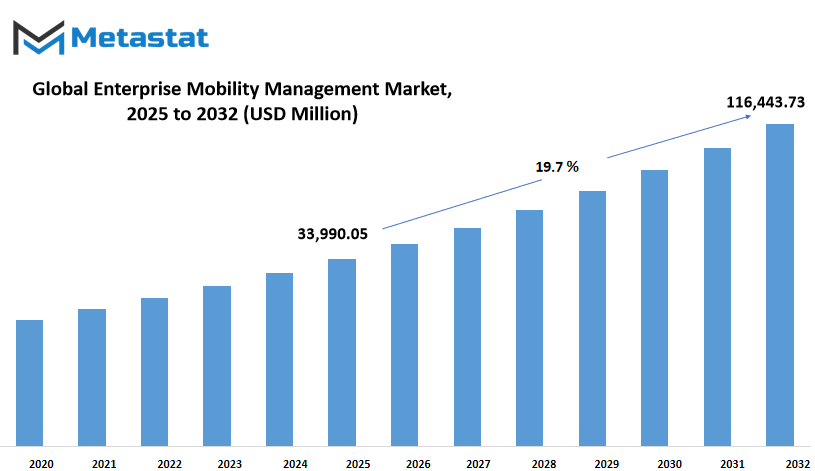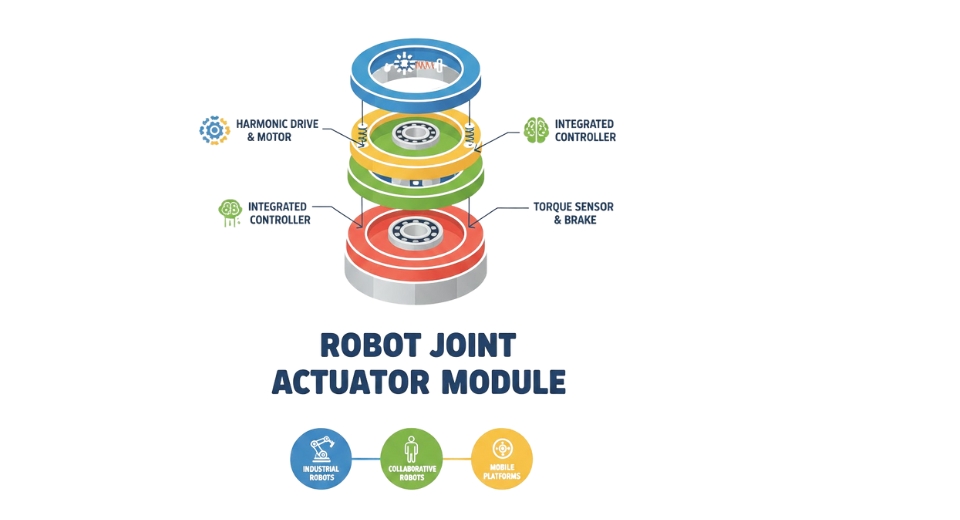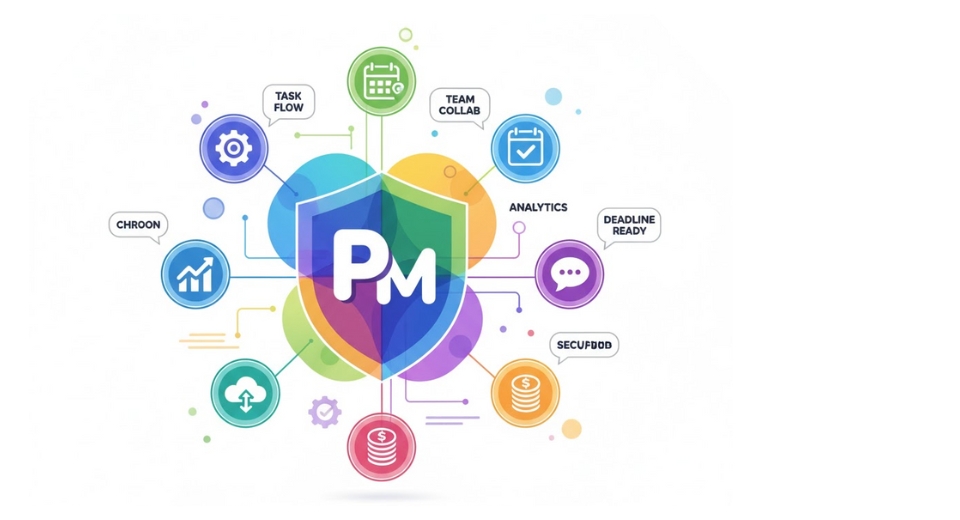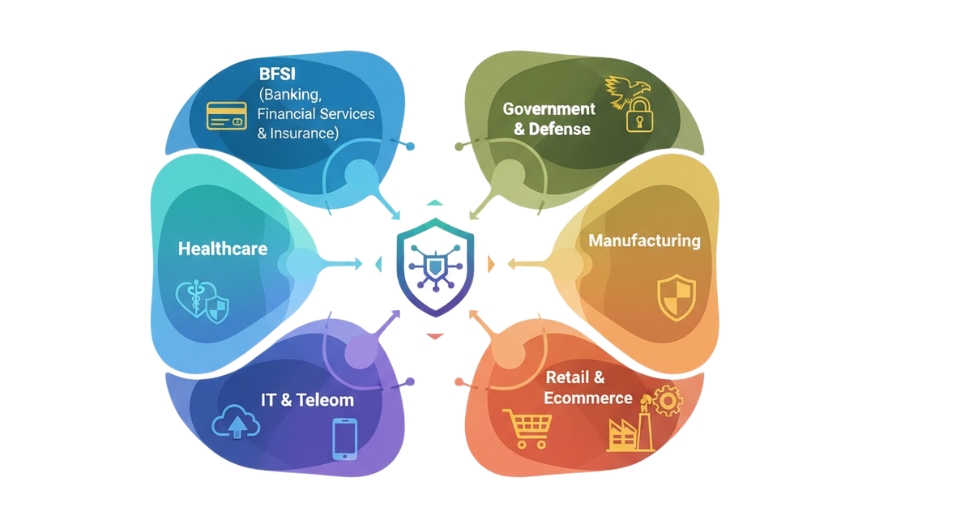MARKET OVERVIEW
The global enterprise mobility management market, based on the corporate and digital mobility sector, will continue to redefine organizational operations across work cultures, locations, and devices in the years to come. It will not be simply about managing mobile devices or protecting remote access in the years ahead but will instead evolve into a strategic enabler that organizations leverage in order to bridge the divide between control and operational freedom. This shift will be less about device management and more about experience management, behavior, and data flow in a mobile-first environment.
As organizations get more agile and geographically spread out, the nature of Enterprise Mobility Management will extend beyond traditional app management and device tracking. It will no longer be regarded as an IT procedure, but as a productivity, data integrity, and decision-making foundation for decentralized environments. As hybrid work patterns become entrenched, the demand for solutions that preserve synchrony between corporate environments and the mobile workforce will increase. The market will see a change in focus from simple monitoring towards smart orchestration coordinating user activity, application usage, and data transfer across multiple ecosystems.
What distinguishes the future direction of the global enterprise mobility management market is its integration into larger organizational ecosystems, specifically those powered by artificial intelligence, behavioral analytics, and zero-trust security models. Instead of operating independently, mobility management platforms will be integrated into business process optimization systems, facilitating fluid collaboration without sacrificing control or compliance. Businesses will seek ways to automate regulatory processes, monitor user behavior, and dynamically modify access rights based on contextual information, all made possible with more advanced mobility solutions.
While regulatory environments become ever more complex, organizations will turn to the global enterprise mobility management market not only for protection, but for conformity with region-specific governance frameworks. This will translate into a diversification of EMM solutions for industry-specific requirements ranging from the healthcare sector's focus on patient confidentiality to finance's need for real-time encryption and verification of data. In the process, EMM will become less of a generic toolset and more of a sophisticated strategy facilitator for industries with distinctive operational issues.
In addition, the convergence of promoted reality, virtual teamwork and edge computing will create new opportunities to enable mobile workforce. EMM will not only enable enterprises to support such innovations; This will be important for their safe, scalable rollouts.
IT organizations will no longer act as a rear-end support function-they will take advantage of real-time insight, future maintenance and workforce engagement analytics providing mobile platforms and will run enterprise changes.
Eventually, the global enterprise mobility management market will spread beyond its current definitions and expectations. This enterprise will develop in a dynamic layer of architecture that supports not only mobility, but adaptability. Instead of being a device of the restriction, it will empower organizations to make real-time, data-operated decisions with mobile-first thinking at their core. This change will define the reaction to business talent organization, border cross communication, and future challenges-with a mobile future which is agile and safe.
Global enterprise mobility management market is estimated to reach $116,443.73 Million by 2032; growing at a CAGR of 19.7% from 2025 to 2032.

GROWTH FACTORS
The global enterprise mobility management market is slowly remodeling the manner companies do business in a world wherein work not takes place inside an workplace. As groups increasingly enable remote work arrangements and undertake convey-your-own-tool (BYOD) policies, there's an increasing demand for sincere and secure mobility solutions. Employees nowadays count on with a view to access company-related information at the pass, whether or not they are at domestic, on the pass, or on enterprise travels. This change is convenient and flexible however also pressures groups to see to it that sensitive data stays steady on a wide set of personal devices and networks.
Part of the primary motive at the back of this marketplace's pace lies within the increased cognizance on safety. With mobile get admission to turning into ubiquitous, so do the threats. Mobile endpoint cyberattacks have multiplied in each quantity and class, prompting businesses to boom their defenses. Some are doing so by shifting their focus to enterprise mobility management solutions that enable more command and control over, monitoring of, and defense of devices used by employees. These systems not only facilitate access management but also make sure that any possible danger is immediately reported and addressed before it becomes a bigger problem.
In spite of these advantages, it is not being easy for all companies to implement such systems. For small businesses in particular, it is the installation cost, along with incorporating these solutions into current hardware, that is acting as a big roadblock. Whereas big companies can point to specific IT budgets, small companies usually lack the justification for making the investment, even when they grasp the potential consequences of a lack of proper mobile management. There's also the people side of change. Some employees consider mobility management to be intrusive. The prospect that their personal devices might be monitored or controlled by their company doesn't sit well with all. This resistance can delay or even disallow deployment in some organizations.
In the future, though, there is still strong potential for growth in the global enterprise mobility management market. With integration into technologies consisting of synthetic intelligence, possibilities are getting newly available. Using AI-primarily based analytics, agencies will be able to identify threats greater fast, song compliance higher, and reply in real time without the want for regular guide intervention. These technologies now not most effective will make mobility management shrewd but additionally extra dynamic, assisting businesses in establishing a stability between safety and flexibility. As the sector becomes aware and solutions end up cost-effective and employee-friendly, greater enterprises will observe suit to remain competitive and secure in a virtual-first global.
MARKET SEGMENTATION
By Solution Type
The global enterprise mobility management market, as brought to the fore by Metastat Insight in an in-depth industry report, will continue to grow as companies transition towards more flexible and remote work arrangements. This transformation isn't only a trend it's becoming an underlying transformation in the way organizations run. At the heart of this transformation is the requirement to maintain data privacy, keep employees connected, and manage devices optimally across varying locations and networks.
With more businesses embracing more digital technology, the need for robust mobility solutions is increasing. These solutions assist organizations in safeguarding confidential information but still allow employees to do their work remotely. Issuing devices and installing applications is no longer sufficient. What organizations require today is a systematic solution that can manage all the way from protecting data to managing applications, tracking devices, and compliance under one roof.
The Solution Type of the global enterprise mobility management market is also broken down into Software, worth $23,487.18 million, and Services. The dominant solution here is software, offering the essential tools companies use to orchestrate their mobile infrastructure. They are platforms for security, distribution of applications, and access control. When organizations expand and the requirements change, such software tools get modified and scaled up to address new demands. In the meantime, the Services segment comprises assist, consulting, and training requirements for agencies in want of assistance rolling out or pleasant-tuning their systems. These offerings sit down in the center among the era and the those who use it, ensuring the whole lot goes in accordance to devise.
The increasing number of cellular gadgets inside the place of work introduces convenience and complexity. Smartphones, drugs, or laptops, it doesn't rely – all want to be synchronized with enterprise systems, blanketed from threats, and tracked without hampering productivity. That's while organization mobility management turns into not only useful however a demand. It assists IT personnel in implementing regulations, resolving troubles in a well timed manner, and ensuring business operations run smoothly without an interruption.
Security will continue to be a top priority as the market grows. With cyber attacks getting more sophisticated, companies can't do without gaps in their systems. Enterprise mobility solutions have layers of protection encryption to full remote wipe capabilities available to protect against loss and breach of data. All these help instill trust between businesses and their customers, with the knowledge that sensitive data is being treated seriously.
Another explanation for the global enterprise mobility management market consistent expansion is the transition to cloud-based solutions. These enable companies to handle all of their needs from one dashboard, with updates and patches deployed rapidly across all devices. It's a shift that facilitates both speed and efficiency, two things that contemporary companies can't live without. As more organizations spend on cloud technology, enterprise mobility platforms will advance in tandem with them.
By Deployment Type
The global enterprise mobility management market is undergoing a huge shift with companies further adopting digital resources that enable remote work, bring-your-own-device (BYOD) policies, and easy access to enterprise information. With workplaces going mobile, companies are focusing on solutions that not only secure their data but also provide effective communication and collaboration between teams.
Enterprise Mobility Management, commonly referred to as EMM, is a collection of tools and technologies designed to assist companies in managing mobile devices, protecting data, and asserting control over mobile apps used by employees. Such solutions have become imperative in the current work environment, where security and flexibility must coexist. The move towards mobile-first approaches also translates into other business adjustments, as companies seek ways to empower employees no longer bound by fixed office environments. From home, on the road, or with clients on-site, employees require secure data access, and that's where EMM comes into play.
The global enterprise mobility management market is reported in various segments, one of which segment is related to deployment type. Under this category, the market is segmented into Cloud-based and On-premises solutions. Cloud-based deployment is increasing its popularity as it provides flexibility, rapid update capabilities, and minimizes the requirement of large IT infrastructure. It enables companies to extend their operations quickly and utilize services from almost anywhere. However, some organizations retain a preference for On-premises deployment, particularly those with strong data control regulations or regulatory compliance. This process maintains information inside the company's internal servers and allows them to have more direct control over their systems.
As generation advances, each kinds of deployment are becoming more efficient and stable. Nevertheless, the decision between them usually relies upon on a agency's unique necessities, budget, and infrastructure. While small corporations and startups can experience the fee-effectiveness and accessibility of the cloud, large companies might decide on On-premises for greater control and customization.
In overall, the global enterprise mobility management market is defining how companies perform inside the modern-day connected world. The emphasis is on making answers easy to apply, steady, and able to aid a international and cell workforce. As an increasing number of corporations embody mobile, the need for relied on and scalable EMM solutions will preserve developing, evolving to satisfy the needs of businesses everywhere in the destiny.
By Enterprise Size
The global enterprise mobility management market keeps expanding as companies evolve with changing work practices, more mobile device usage, and an emphasis on growing data security. An essential part of this market is the way in which it's influenced by various kinds of enterprises. On the basis of Enterprise Size, the global enterprise mobility management market is again segmented into Small and Medium-sized Enterprises, Large Enterprises. All these segments engage with mobility solutions uniquely, depending on their requirements, means, and digital maturity.
Small and Medium-sized Enterprises (SMEs) are inclined to implement mobility tools as a means of promoting a level playing field. Since these companies usually have minimal infrastructure and small groups, mobile-friendly solutions assist in keeping them competitive. They need adaptable tools that enable remote work, secure access to data, and rapid communication all without heavy investments. Mobility management can make device control easy for SMEs, minimize IT workload, and maintain their operations streamlined while growing. With increasing numbers of people working remotely from other locations, keeping devices and data secure has become unavoidable, not a choice.
Large Enterprises, on the other hand, function on a larger scale, frequently across numerous locations and time zones. Their mobility requirements are more sophisticated, with stringent security measures, cross-departmental employee onboarding, and handling a large device set. Their priority is integration with current infrastructure and adherence to international regulations. They view company mobility as plenty extra than flexibility; it is approximately manipulate, oversight, and stability in the long time. They most often want sophisticated answers that provide analytics, tracking of consumer behavior, and frictionless access to company assets from any authorized device.
The difference in how various employer sizes respond to mobility management highlights the flexibility of the marketplace. Solutions formerly used in area of interest industries are actually being reengineered for organizations of all sizes. Since both SMEs and massive companies are seeking for to maximize productiveness while retaining protection, the market maintains gravitating closer to smarter and extra responsive mobility answers. Companies preference platforms which can scale with them whether or not they are a begin-up or coping with heaps of customers international. This combination of elegance and complexity is what continues the demand going.
By End User
The global enterprise mobility management market, based on give up users, is segmented into industries which include retail, healthcare, IT and telecom, banking, monetary offerings and coverage (BFSI), manufacturing, transportation and logistics, authorities, and other sectors. Each of those regions has specific demands, however all share the developing want to aid a cellular-first technique. Businesses throughout those sectors are more and more depending on stable access to work statistics and applications across numerous gadgets and locations, prompting a shift in how IT infrastructure is managed.
Retail companies, as an example, are focusing more on mobile tools for income staff and stock management, which improves customer support and operational performance. In healthcare, there is a clear push toward mobility as docs and nurses require quick get admission to to affected person information from numerous points inside or outdoor of scientific centers. IT and telecom agencies are frequently early adopters, the use of organisation mobility solutions to streamline operations, assist far flung workforces, and maintain network protection.
The BFSI section relies heavily on steady communication and statistics get right of entry to, making mobility tools vital for coping with transactions and customer interactions in a secure surroundings. Manufacturers, too, are embracing cell answers at the production floor and in supply chains, where actual-time updates can lessen downtime and optimize workflows. Meanwhile, transportation and logistics companies benefit from better path tracking, shipping coordination, and on-the-go records get admission to.
Governments also are adapting, imposing mobility techniques to enhance carrier delivery, facts management, and coordination amongst departments. And then there’s the broader “others” class, which covers businesses that don’t in shape smartly into those sectors but nevertheless understand the benefits of a cell-enabled body of workers.
Overall, using organisation mobility solutions is spreading steadily across unique sectors, pushed through the need for flexibility, quicker decision-making, and stable get admission to to statistics from everywhere. As this trend keeps, industries will maintain reshaping how work gets performed, all at the same time as adapting to new technologies that aid cellular agency environments.
|
Forecast Period |
2025-2032 |
|
Market Size in 2025 |
$33,990.05 million |
|
Market Size by 2032 |
$116,443.73 Million |
|
Growth Rate from 2025 to 2032 |
19.7% |
|
Base Year |
2024 |
|
Regions Covered |
North America, Europe, Asia-Pacific, South America, Middle East & Africa |
REGIONAL ANALYSIS
The global enterprise mobility management market is seeing a shift in how agencies deal with cell gadgets, applications, and statistics. As groups grow extra digital, the demand for secure and efficient mobility solutions is rising. Organizations not restriction paintings to the bounds of office walls. Teams have become more mobile, operating across towns, time zones, and even continents. This trade brings convenience but also demands stricter manage over corporate records, especially on employee gadgets. Enterprise Mobility Management, regularly shortened to EMM, facilitates companies gain that balance supplying flexibility while maintaining safety intact.
Geographically, the global enterprise mobility management market is dependent into numerous regions. North America includes the USA, Canada, and Mexico. Europe stretches across the UK, Germany, France, Italy, and other elements of the continent grouped beneath the Rest of Europe. In Asia-Pacific, the market extends through India, China, Japan, South Korea, and different neighboring international locations. South America includes Brazil, Argentina, and its remaining countries, at the same time as the Middle East & Africa consists of GCC Countries, Egypt, South Africa, and the Rest of Middle East & Africa. Each of those areas has its very own tempo of virtual boom and demand for mobile control systems.
North America is anticipated to guide the price, especially due to the speedy adoption of generation and better recognition of mobile-associated dangers. The U.S. Particularly has a robust presence of big establishments and tech-pushed companies, which certainly pushes the demand for classy mobility solutions. Canada and Mexico are also adapting speedy, especially with go-border enterprise operations requiring seamless records access and device utilization.
Europe follows with its solid virtual framework. Countries like Germany and the United Kingdom are at the leading edge, with organizations making an investment in superior IT infrastructure. France and Italy aren't a ways behind, and the wider European place is progressively picking up velocity. The attention across those countries remains on defensive facts privacy at the same time as permitting employees the liberty to work at the pass.
Asia-Pacific stands out for its sheer scale and capacity. Nations like China and India are hotbeds of digital innovation. With a big populace and growing smartphone penetration, corporations here are turning to EMM equipment to control cell workflows securely. South Korea and Japan, recognized for his or her superior tech industries, also are crucial participants to this market section. As virtual work conduct spread even into smaller firms and startups, the Rest of Asia-Pacific is anticipated to show steady growth.
South America, with Brazil and Argentina inside the lead, is slowly warming as much as the concept of enterprise mobility as extra companies begin to explore bendy paintings preparations. As the infrastructure improves and recognition spreads, call for EMM answers will probable rise. Meanwhile, in the Middle East & Africa, international locations like the UAE, Saudi Arabia, and South Africa are building strong digital ecosystems. With growing investments in IT and cell networks, the want for higher mobility equipment is becoming greater obtrusive. Egypt and the alternative countries on this vicinity are catching on as they modernize their enterprise environments.

COMPETITIVE PLAYERS
Presented via Metastat Insight, the global enterprise mobility management market is present process a major transformation as groups respond to the growing want for steady, flexible mobile answers. With the developing shift toward hybrid paintings and a mobile-first approach, businesses round the arena are recognizing the need to assist personnel past the conventional office setup. This trend isn't truely about supplying mobile get entry to it is approximately making sure productivity, safety, and consistency irrespective of wherein paintings takes place.
In current years, organizations have started out setting more price on structures that manage cell gadgets, packages, and content in a single streamlined platform. What turned into as soon as regarded as a convenient upload-on is now visible as a have to-have for organizations wanting to live aggressive and keep their information included. The recognition is now not simply on permitting far off work, but on handling it with clarity and control. Whether an employee is operating from home, touring, or connecting via their non-public device, organizations need to make certain they’re doing it in a way that aligns with commercial enterprise rules and protection standards.
The shift has caused the developing adoption of solutions from most important players including Cisco Systems, Inc., SAP SE, AppTec GmbH, VMware, Inc., and Citrix Systems. These groups are leading the way via supplying systems that not handiest assist control gadgets but also offer real-time analytics, compliance tracking, and danger control tools. Others like Ivanti, IBM Corporation, and Microsoft Corporation have additionally been expanding their offerings, aiming to combo cell management with broader IT features.
Zoho Corporation Pvt. Ltd., Matrix42, Sophos, and BlackBerry Limited keep to construct their market presence with gear that guide corporations of numerous sizes.
As extra businesses manage touchy information on cellular gadgets, the need for strong safety will become more difficult to ignore. Managing threats, stopping statistics leaks, and maintaining consumer privacy are pinnacle priorities. Companies are investing in solutions that don’t just paintings in the heritage, however actively guard customers without disrupting workflow. The intention is to create a stability giving employees the freedom to paintings how they want whilst still following corporation guidelines and protection tips.
What makes the global enterprise mobility management market in particular vital is the way it touches almost every enterprise. From healthcare and finance to training and logistics, the call for for dependable business enterprise mobility answers is spreading. Each region has its personal needs, but the common thread is a choice for control, flexibility, and protection. This rising call for continues to push vendors to enhance their services and adapt to the real-international demanding situations businesses face day by day.
Looking ahead, the global enterprise mobility management market will in all likelihood preserve growing as virtual transformation picks up pace. Companies will continue to prioritize platforms that no longer handiest connect groups throughout places but also reduce risk and improve performance. While the gear and technologies may exchange, the need for realistic, secure, and user-friendly mobility solutions is here to stay.
Enterprise Mobility Management Market Key Segments:
By Solution Type
- Software
- Services
By Deployment Type
- Cloud-based
- On-premises
By Enterprise Size
- Small and Medium-sized Enterprises
- Large Enterprises
By End User
- Retail
- Healthcare
- IT & Telecom
- BFSI
- Manufacturing
- Transportation and Logistics
- Government
- Others
Key Global Enterprise Mobility Management Industry Players
- Cisco Systems, Inc.
- SAP SE
- AppTec GmbH
- VMware, Inc.
- Citrix Systems
- Ivanti
- IBM Corporation
- Microsoft Corporation
- Zoho Corporation Pvt. Ltd.
- Matrix42
- Sophos
- BlackBerry Limited
WHAT REPORT PROVIDES
- Full in-depth analysis of the parent Industry
- Important changes in market and its dynamics
- Segmentation details of the market
- Former, on-going, and projected market analysis in terms of volume and value
- Assessment of niche industry developments
- Market share analysis
- Key strategies of major players
- Emerging segments and regional growth potential








 US: +1-(714)-364-8383
US: +1-(714)-364-8383






